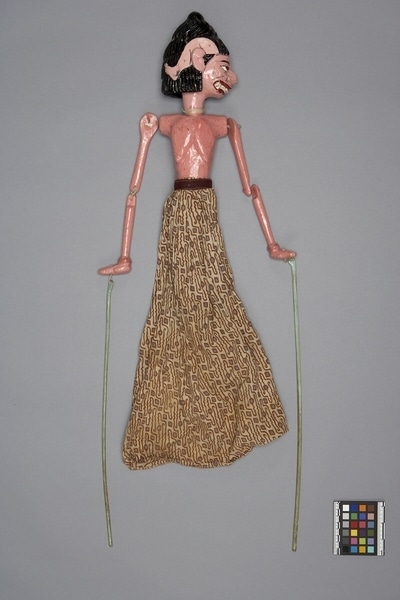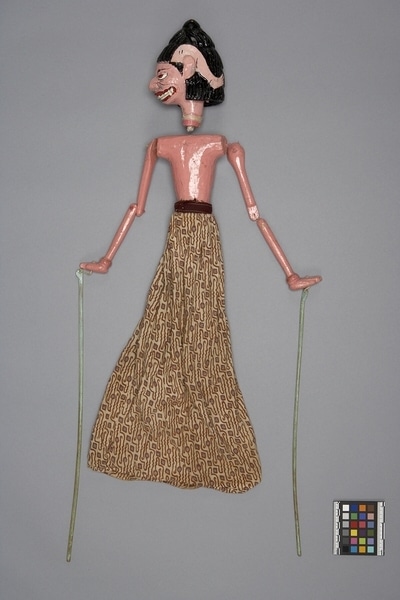Rod Puppet Item Number: Ib346 from the MOA: University of British Columbia


Description
Human-like figure with detachable head, body and rod. Pink face; eyes with red irises. Short pointed nose, red open mouth with overbite exposing an upper and lower fang in each corner of the mouth. Loose hanging black hair with pink foot ornament around each ear. Upper body is pink and uncovered; sagging breasts. Arms jointed at shoulder and elbow, attached with string. Hands upturned; controlling wands attached to hands with string. One arm cannot be fully extended. Skirt material has brown pattern with diamond and circles, blue and white centres.
History Of Use
Javanese puppetry as an art form probably developed by the 11th century. The three-dimensional wooden wayang golek puppets of western Java appeared during the 16th century. Originally the plays depicted Javanese mythology, but after the Indian conquest of Java the Hindu epics, Ramayana and Mahabharata, were incorporated into the cycles, which comprise about 200 plays. An individual or group hires a dalang (puppet-master) to celebrate important occasions. The performances often last all night and are generally presented in three acts, with vocal and instrumental accompaniment. The individual plays vary widely in detail but usually involve conflict between good and evil. They serve a moral and religious purpose, and more recently, one of political commentary. Each puppet's character is represented by its appearance and placement onstage; protagonists with strong elements of good are placed to the right, antagonists of violent or evil nature to the left. Durgal can appear in plays based on both of the major Hindu epics. She is the daughter of Shiva and Dewi Uma, and wife of Balarakala. Role she fills in plays is not known: as with most gods she can support who she pleases but appears to the right of the stage.
Cultural Context
Theatrical performance.
Iconographic Meaning
Pink face, loose black hair, fangs and breasts are all distinguishing characteristics of Durgal, goddess of the kingdom of the dead.
Item History
- Made in Java, Indonesia
- Owned by Tradewind Antiques before March 15, 1983
- Received from Museum of Anthropology Shop Volunteers (Funding source) and Tradewind Antiques (Seller) on March 15, 1983
What
- Name
- Rod Puppet
- Identification Number
- Ib346
- Type of Item
- puppet
- Material
- wood, cotton fibre, paint and fibre
- Manufacturing Technique
- carved, painted, machine woven, sewn and tied
- Part C
- height 66.0 cm, width 6.0 cm, depth 2.1 cm
- Part B
- height 18.0 cm, width 8.0 cm, depth 15.0 cm
- Part A
- height 55.0 cm, width 21.0 cm, depth 5.0 cm
Who
- Culture
- Sundanese
- Previous Owner
- Tradewind Antiques
- Received from
- Museum of Anthropology Shop Volunteers (Funding source) and Tradewind Antiques (Seller)
Where
- Holding Institution
- MOA: University of British Columbia
- Made in
- Java, Indonesia
When
- Ownership Date
- before March 15, 1983
- Acquisition Date
- on March 15, 1983
Other
- Condition
- good
- Accession Number
- 0886/0080